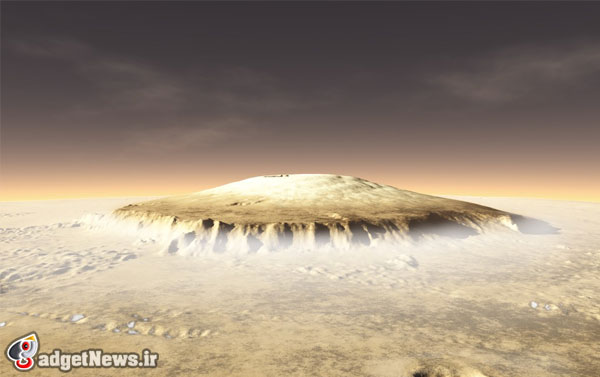
اورست بلندترین کوه زمین به شمار میرود اما این کوه بلندترین کوه منظومه شمسی نمی باشد، بلکه قله کوه “المپیوس” با ارتفاعی بیش از ۲۵ کیلومتر مرتفع ترین کوه سامانه خورشیدی است که بیش از ۳ برابر قله اورست ارتفاع دارد، این کوه می تواند تا صد قله دماوند را در خود جای دهد.
کوه المپوس( Olympus Mons) بلندترین کوه سامانه خورشیدی است. که در سیاره مریخ و با مختصات ۱۸°N 133°W / 18, -133 قرار دارد. ارتفاع آن بیش از ۲۵ کیلومتر است و پهنایی به اندازه کشور نپال دارد. قطر دهانه آن ۸۰کیلومتر و پهنای پایه مخروط آتشفشان به ۶۲۴ کیلومتر میرسد که با دشتهای مسطح احاطه شده است. منطقه آتشفشانی تارسیس در مریخ در حقیقت خانه تعدای از بزرگترین آتشفشانها در منظومه شمسی است. قله آسکرئوس و الیسیوم که به ترتیب ۱۴.۹ و ۱۲.۶ کیلومتر ارتفاع دارند، در این منطقه واقع شده اند. سیاره سرخ بدلیل ساختار زمین شناختی خود و جاذبه اندکش محل مناسبی برای تولد آتشفشانهای غول پیکر است.
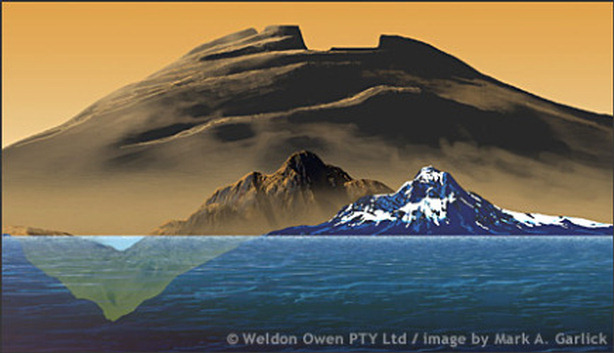
تصویری از کوه المپوس در مقایسه با کوه اورست
در مریخ دریا و اقیانوسی وجود ندارد تا بتوان از معیار « سطح ارتفاعی عوارض دریای آزاد» استفاده کرد، قاعدتاً یک سطح صفری را به عنوان مرجع تعیین ارتفاع در این سیاره بایستی در نظر گرفت. به این سطح Areoid of Mars میگویند که معادل ژئویید یا سطح مبنای ارتفاعی (geoid) در زمین است. ژئویید (Geoid) حالتی تعریف میشود که سطح اقیانوسهای زمین در وضعیتی قرار داشته باشند که سطح ارتفاعشان فقط تحت تأثیر گرانش زمین باشند، به طوری که اثر باد و جریانهای اقیانوسی و جزر و مدی در ارتفاع سطح دریاها حذف شده باشد.

سطح صفر در مریخ جایی تعریف میشود که فشار اتمسفر در آنجا ۶۱۰.۵ پاسکال باشد. این مقدار فشار برگرفته از نقطهی سهگانهی آب (Triple point of Water) است. در نقطهی سهگانهی یک ماده، در فشار و دمای مشخصی هر سه فاز جامد و مایع و گاز آن ماده میتوانند به صورت همزمان در تعادل ترمودینامیکی وجود داشته باشند. در مورد نقطهی سهگانهی آب، مقدار فشار حدود ۰.۶ درصد فشار هوا در سطح دریاهای آزاد است؛ یعنی معادل ۰.۰۰۶ اتمسفر. در این حالت، یعنی از ارتفاعی در سطح مریخ که فشار ۰.۰۰۶ اتمسفر زمین باشد، ارتفاع کوه المپوس در مریخ طبق منابع بیش از ۲۵ کیلومتر ذکر شده است.
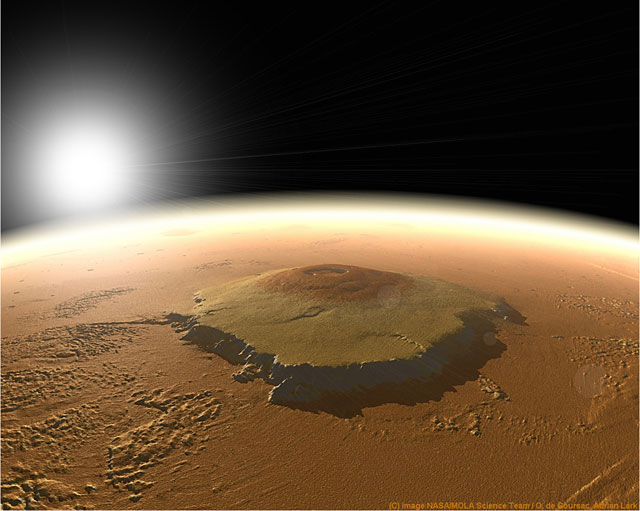
نمایی هنری از المپوس در افق مریخ
این یک تعریف تئوری برای تعیین سطح صفر در مریخ بود و امروزه در عمل این سطح به طور مستقیم براساس اندازهگیریهای گرانشی ماهوارهای تعیین میشود. گاهی هم عوارض در سیارات خاکی بر اساس ارتفاعشان از متوسط سطح دشتهای اطراف همان عارضه بیان میشود. همین طور گاهی ارتفاع و عمق عوارض به ویژه در زمینشناسی بر اساس ارتفاع از Geodetic Datum تعریف میشود که در این حالت با توجه به کاملاً کروی نبودن سیارات و پَخ بودنشان در استوا، ارتفاع عوارض نسبت به حالتی که سیاره اگر کاملاً کروی بود بیان میشود. در این حالت ارتفاع کوه المپوس در مریخ ۲۱۲۲۹ متر بیان شده است.
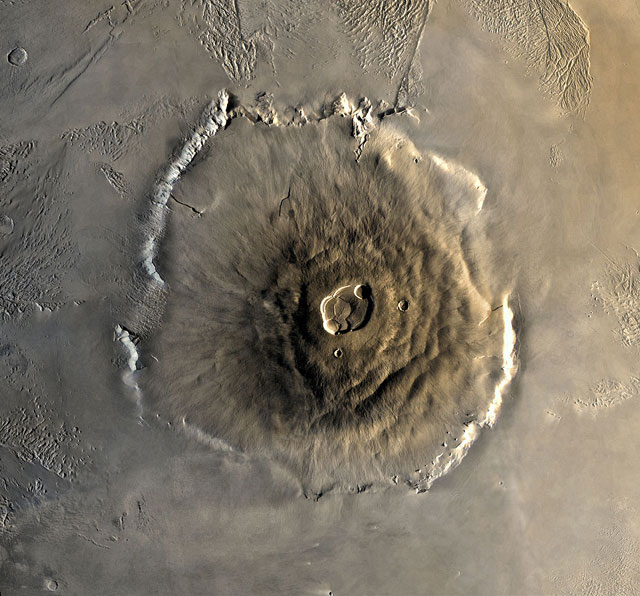
تصویری از کوه آتشفشانی المپوس که مدارگرد وایکینگ ۱ به ثبت رسانده است
مریخ چهارمین سیاره در سامانه خورشیدی است که در مداری طولانی تر از زمین و با سرعتی کمتر از زمین حرکت میکند. هر یک باری که به بدور خورشید میچرخد معادل ۶۸۷ روز (روز زمین) به درازا میکشد و شب و روز کمی طولانیتر از کره زمین است. بزرگی این سیاره نزدیک به یک دوم زمین است و قطر آن ۶۷۹۰ کیلومتر میباشد. جوّ آن شامل ۹۵ درصد دی اکسید کربن، ۳ درصد نیتروژن، ۱٫۶ درصد آرگون و فقط مقدار ناچیز اکسیژن و آب وجود دارد. جو سیاره سرخ بسیار رقیق است، به طوری که فشار جوی سطح آن، معادل یک صدم فشار جو زمین در سطح دریاست. علاوه بر این جو مریخ محافظ خوبی در برابر تابشهای مرگبار فضایی نیست. بیشتر مناطق مریخ بسیار سرد است. دمای هوا در قطبهای آن میتواند تا ۱۳۰ درجه زیر صفر پایین برود.
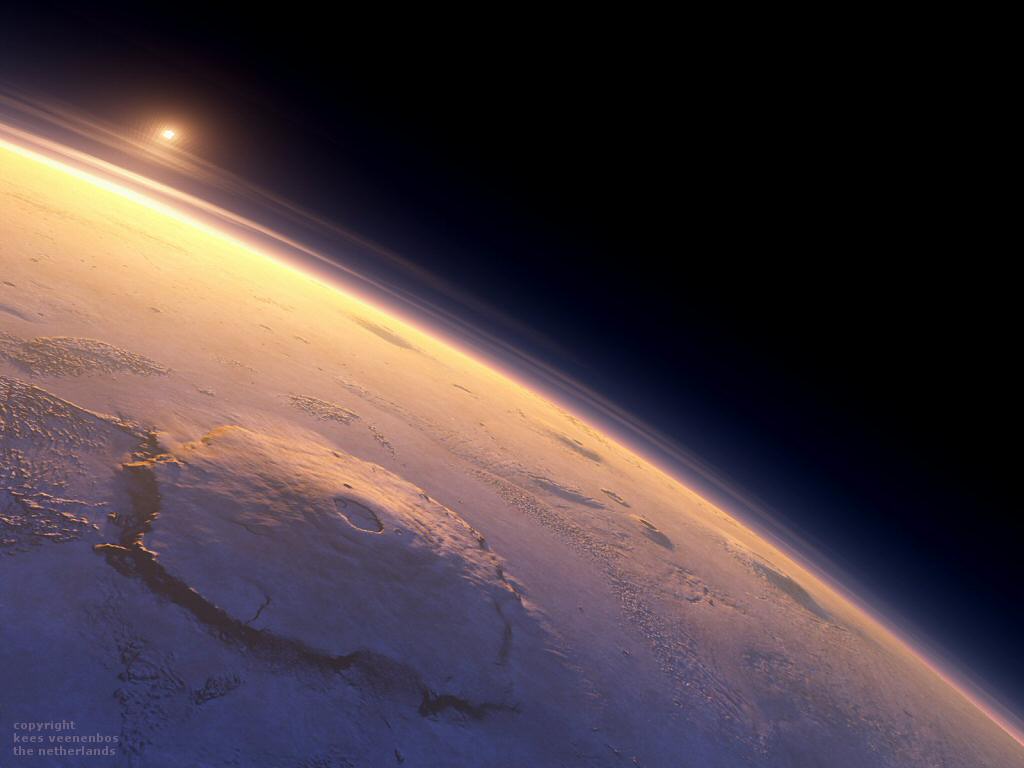
تصویری هنری از المپوس در افق زیبای مریخ
منبع : space
Olympus Mons: Giant Mountain of Mars
Olympus Mons is the largest volcano in the solar system. The massive Martian mountain towers high above the surrounding plains of the red planet, and may be biding its time until the next eruption.
Characteristics
Found in the Tharsis Montes region near the Martian equator, Olympus Mons is one of a dozen large volcanoes, many of which are ten to a hundred times taller than their terrestrial counterparts. The tallest of them all towers 16 miles (25 kilometers) above the surrounding plains and stretches across 374 miles (624 km) — roughly the size of the state of Arizona.
In comparison, Hawaii's Mauna Loa, the tallest volcano on Earth, rises 6.3 miles (10 km) above the sea floor (but its peak is only 2.6 miles above sea level). The volume contained by Olympus Mons is about a hundred times that of Mauna Loa, and the Hawaiian island chain that houses the Earthly volcano could fit inside its Martian counterpart.
Olympus Mons rises three times higher than Earth's highest mountain, Mount Everest, whose peak is 5.5 miles above sea level.
Olympus Mons is a shield volcano. Rather than violently spewing molten material, shield volcanoes are created by lava slowly flowing down their sides. As a result, the mountain has a low, squat appearance, with an average slope of only 5 percent.
Six collapsed craters, known as calderas, stack on top of one another to create a depression at the summit that is 53 miles wide (85 km). As magma chambers beneath the calderas emptied of lava, most likely during an eruption, the chambers collapsed, no longer able to support the weight of the ground above.
A cliff, or escarpment, surrounds the outer edge of the volcano, reaching as high as 6 miles (10 km) above the surrounding area. (The cliff alone is about as tall as Mauna Loa.) A wide depression surrounds the base of the volcano as its immense weight presses into the crust.
Olympus Mons is still a relatively young volcano. Although it has taken billions of years to form, some regions of the mountain may be only a few million years old, relatively young in the lifetime of the solar system. As such, Olympus Mons may still be an active volcano with the potential to erupt.
The tallest volcano in the solar system may also house rock glaciers — rocky debris frozen in ice. Snow and ice deposits above the base of the shield could result in such glaciers. Water-ice insulated by surface dust may exist near the top of the volcano. The tops of these glaciers may host ridges, furrows, and lobes, and be covered by rocks and boulders, and could be as young as four million years old.
Forming a giant
Why would such a huge volcano form on Mars but not on Earth? Scientists think that the lower surface gravity of the red planet, combined with higher eruption rates, allowed for the lava on Mars to pile up higher.
The presence and absence of tectonic plates could also play an important role in the different kinds of volcanoes. The hot spots of lava under the crust remain in the same location on both planets. On Earth, however, the movement of the crust prevents the steady buildup of lava. The Hawaiian Islands, for instance, formed as a plate drifted over a hot spot. Each eruption created a small island in a different spot.
But Mars has very limited plate movement. Both the hot spot and the crust remain unmoving. When lava flows to the surface, it continues to pile up in a single spot. Instead of a chain of volcanic islands, large volcanoes such as Olympus Mons form. In fact, three other large volcanoes near Olympus Mons are similarly gigantic; if only one of the four volcanoes in the region existed, it would be the tallest feature in the solar system.
The volcanoes in Tharsis Montes are so large that they tower above the seasonal Martian dust storms. Italian astronomer Giovanni Schiaparelli, who studied the Martian surface intensively in the late 19th century, observed the enormous features from Earth using an 8-inch (22 centimeter) telescope. When NASA's Mariner 9 arrived at the red planet in 1971, it was able to pick out the tops of the volcanoes above the storms.
 گجت نیوز آخرین اخبار تکنولوژی، علم و خودرو
گجت نیوز آخرین اخبار تکنولوژی، علم و خودرو 





